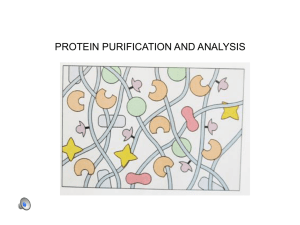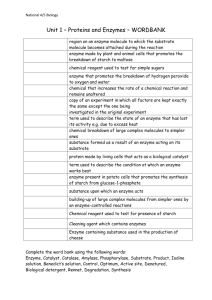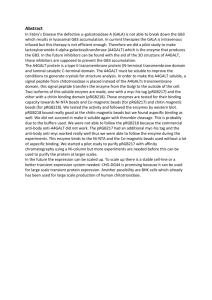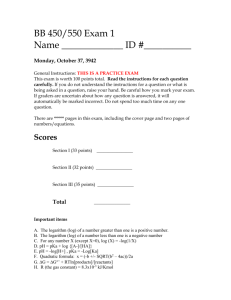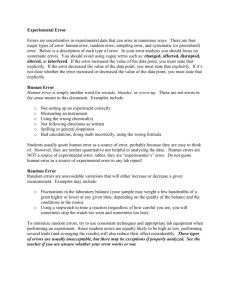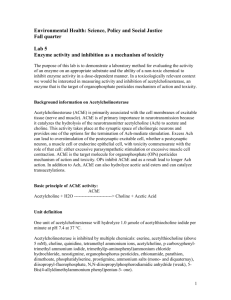KINETIC BEHAVIOR OF CRUDE AND PURIFIED SOLUBLE AND
advertisement
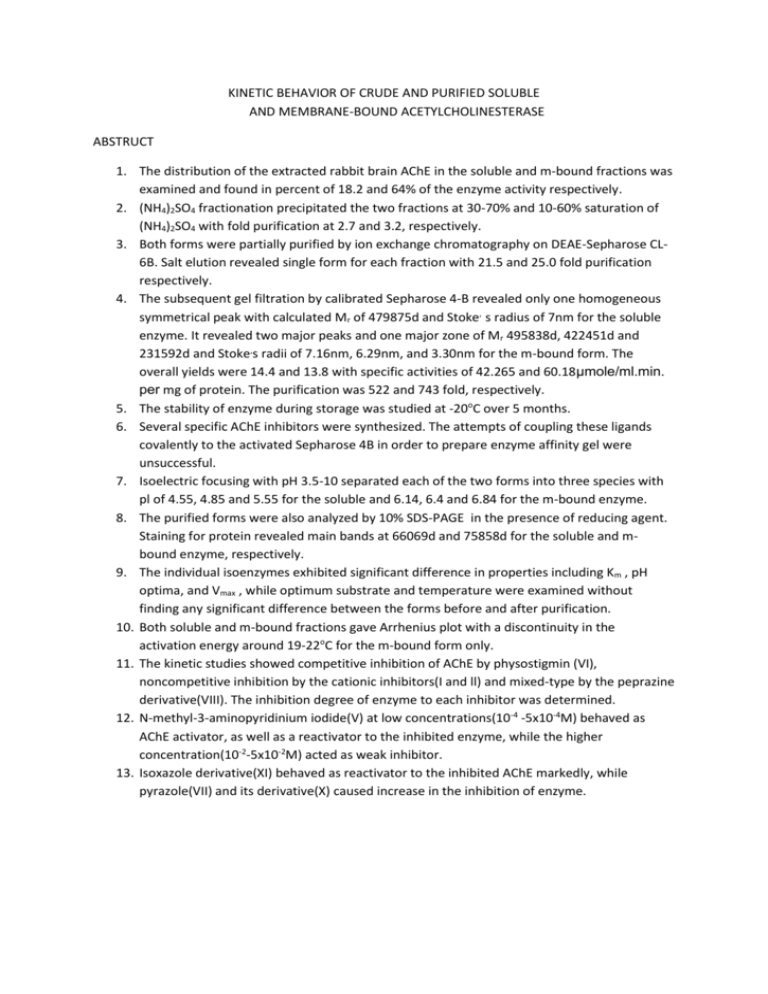
KINETIC BEHAVIOR OF CRUDE AND PURIFIED SOLUBLE AND MEMBRANE-BOUND ACETYLCHOLINESTERASE ABSTRUCT 1. The distribution of the extracted rabbit brain AChE in the soluble and m-bound fractions was examined and found in percent of 18.2 and 64% of the enzyme activity respectively. 2. (NH4)2SO4 fractionation precipitated the two fractions at 30-70% and 10-60% saturation of (NH4)2SO4 with fold purification at 2.7 and 3.2, respectively. 3. Both forms were partially purified by ion exchange chromatography on DEAE-Sepharose CL6B. Salt elution revealed single form for each fraction with 21.5 and 25.0 fold purification respectively. 4. The subsequent gel filtration by calibrated Sepharose 4-B revealed only one homogeneous symmetrical peak with calculated Mr of 479875d and Stoke, s radius of 7nm for the soluble enzyme. It revealed two major peaks and one major zone of Mr 495838d, 422451d and 231592d and Stoke,s radii of 7.16nm, 6.29nm, and 3.30nm for the m-bound form. The overall yields were 14.4 and 13.8 with specific activities of 42.265 and 60.18µmole/ml.min. per mg of protein. The purification was 522 and 743 fold, respectively. 5. The stability of enzyme during storage was studied at -20oC over 5 months. 6. Several specific AChE inhibitors were synthesized. The attempts of coupling these ligands covalently to the activated Sepharose 4B in order to prepare enzyme affinity gel were unsuccessful. 7. Isoelectric focusing with pH 3.5-10 separated each of the two forms into three species with pl of 4.55, 4.85 and 5.55 for the soluble and 6.14, 6.4 and 6.84 for the m-bound enzyme. 8. The purified forms were also analyzed by 10% SDS-PAGE in the presence of reducing agent. Staining for protein revealed main bands at 66069d and 75858d for the soluble and mbound enzyme, respectively. 9. The individual isoenzymes exhibited significant difference in properties including Km , pH optima, and Vmax , while optimum substrate and temperature were examined without finding any significant difference between the forms before and after purification. 10. Both soluble and m-bound fractions gave Arrhenius plot with a discontinuity in the activation energy around 19-22oC for the m-bound form only. 11. The kinetic studies showed competitive inhibition of AChE by physostigmin (VI), noncompetitive inhibition by the cationic inhibitors(I and ll) and mixed-type by the peprazine derivative(VIII). The inhibition degree of enzyme to each inhibitor was determined. 12. N-methyl-3-aminopyridinium iodide(V) at low concentrations(10-4 -5x10-4M) behaved as AChE activator, as well as a reactivator to the inhibited enzyme, while the higher concentration(10-2-5x10-2M) acted as weak inhibitor. 13. Isoxazole derivative(XI) behaved as reactivator to the inhibited AChE markedly, while pyrazole(VII) and its derivative(X) caused increase in the inhibition of enzyme.



